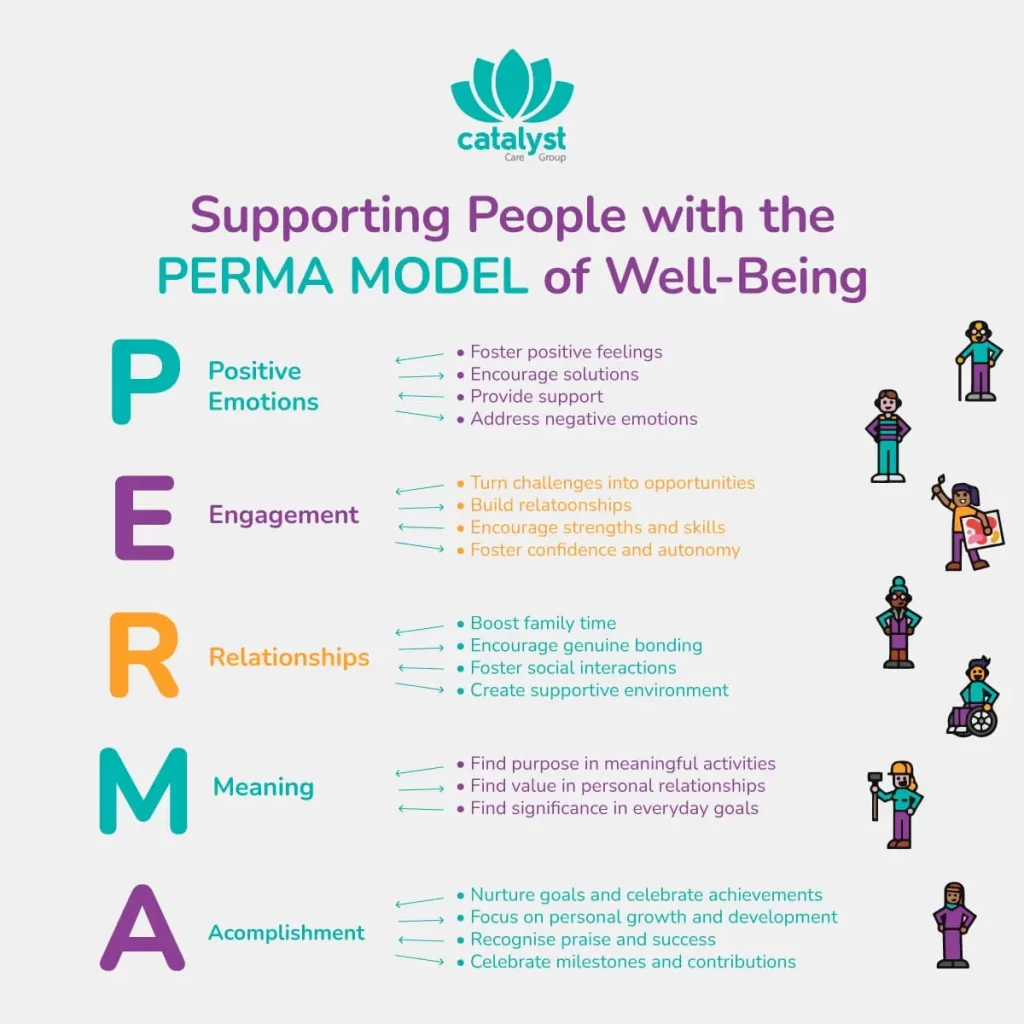Every person in the world dreams of living a happy, fulfilled life, doing the things they love, and being surrounded by the people they love. However, many autistic people, people living with a learning disability, and people with mental health needs are often denied the opportunity to choose where and how they want to live.
Supporting people with the PERMA model of well-being aims to improve their well-being and happiness by promoting positive emotions, engagement, strong relationships, meaning, and accomplishment. By incorporating these elements into care and support practices, the PERMA model seeks to enhance people’s quality of life, happiness, and positive outcomes.

Meaning of PERMA Model
The PERMA model of well-being is an evidence-based approach developed by the father of positive psychology, Martin Seligman.
As the World Health Organisation suggests, well-being is a state of mind in which people can realise their own abilities, manage daily life and stressful life events, and feel productive and able to contribute to the community.
Positive psychology aims to identify people’s strengths and ability to thrive. The PERMA model focuses on the five key areas for well-being to prioritise strengths rather than difficulties. They include Positive Emotion, Engagement, Relationships, Meaning, and Accomplishment.
The model guides people to prioritise key areas in their lives through its five core elements. It encourages engaging in activities that foster love, joy, and gratitude and teaches people to focus on developing and strengthening positive relationships with their loved ones.
PERMA model also helps people build resilience and mechanisms to navigate stressful and unpredicted situations, reducing the risk of behaviours of concern and crisis escalation.
Positive Emotions (P)
The first component of the PERMA model is positive emotions. Positive emotions, such as hope, compassion, pride, and gratitude, are key indicators of flourishing and can be developed over time to enhance well-being.
When people explore and experience positive emotions in their daily lives (including visualisations of their future) improves their habitual thinking and behaviour. Enhancing positive emotions helps people build physical, intellectual, psychological, and social resources, contributing to resilience and overall well-being.
Some ways to cultivate positive emotions include:
- Spending time with loved ones
- Engaging in hobbies and creative activities that bring joy
- Engaging in activities that release positive sensory experiences
- Reflecting on gratitude
Positive emotions improve life satisfaction and contribute to positive outcomes.
Engagement (E)
Engagement refers to becoming deeply absorbed or engrossed in an activity. This is described as experiencing ‘flow’, where someone is truly present. Its deep involvement is highly beneficial for one’s emotions and skill development.
Engaging in activities that one enjoys contributes to overall well-being. The type of activities depends on the person and their interests. For example, someone might love playing guitar and feeling immersed in music, while others may prefer baking and trying new recipes. Engaging in such activities is very beneficial, fostering personal growth and emotional satisfaction.
Some ways to promote engagement:
- Participating in activities people really love, where they can spend hours enjoying themselves
- Spending time in nature, watching, listening, and observing what happens around them
- Supporting people to identify and learn about their strengths
- Finding new activities that people enjoy
Relationships (R)
Relationships encompass all types of interactions people have with partners, friends, family members, colleagues, mentors, and the wider community.
The PERMA model includes relationships because humans are fundamentally social beings. This need for social connection becomes especially significant as we grow older. Research shows that a strong social environment is crucial for preventing cognitive decline and that robust social networks contribute to better physical and mental health.
Studies also suggest that sharing positive experiences and celebrating successes can strengthen bonds. Moreover, responding enthusiastically, especially in close relationships, boosts intimacy, well-being, and satisfaction.
Methods to build positive relationships include:
- Asking questions to learn more about people
- Celebrating people’s wins and successes
- Making sure people feel valued
Positive relationships build a sense of belonging, acceptance and personal growth.
Meaning (M)
Having a sense of purpose helps people focus on what truly matters, especially when facing significant challenges or adversity.
Purpose and meaning vary for each person. It can be pursued through a profession, a social or political cause, a creative project, or religious/spiritual beliefs. It may also be found through volunteer or community activities.
Personal values guide a sense of purpose, and people who feel they have a purpose tend to live longer, experience greater life satisfaction, and experience fewer physical and mental health challenges.
Ways to cultivate meaning include:
- Getting involved in a cause or organisation that is important to you
- Exploring new creative activities to discover what resonates with you
- Considering how you can use your passions to benefit others
- Spending quality time with people you care about
Accomplishments (A)
A sense of accomplishment comes from working towards and achieving goals, learning a task, and being self-motivated to complete your goals. This feeling contributes to well-being by feeling and experiencing a sense of pride.
Accomplishment involves perseverance and passion for achieving goals. However, true flourishing and well-being are achieved when accomplishments are driven by internal motivation or pursuing goals for personal growth and improvement, rather than external rewards.
Focusing on intrinsic goals, such as personal development and connection, often results in greater well-being compared to pursuing external goals like wealth or fame.
Implementing The PERMA Model in Health and Social Care
Using the PERMA Model in health and social care can make a significant difference by focusing on what makes people feel good and reducing restrictive practices. This approach helps create a more positive, supportive environment where everyone can thrive.
- Celebrating Strengths:
- Focus on What’s Good: With the PERMA Model, we start by recognising and celebrating what people do well. By focusing on their unique strengths and passions, we can help people feel valued and encouraged.
- Encourage Growth: Helping people engage in activities they love and are good at makes their days more enjoyable and builds their confidence and sense of achievement.
- Reducing Restrictive Practices:
- Support Independence: The PERMA Model encourages giving people the freedom to explore what interests them and what brings them joy. This shift helps reduce restrictive practices and fosters a more respectful and flexible care environment.
- Create a Positive Space: By integrating positive experiences and meaningful activities, we can make care settings more uplifting and supportive, making it easier for people to feel comfortable and engaged.
- Fostering Positive Outcomes:
- Enhance Well-Being: By focusing on creating positive emotions, engaging activities, and strong relationships, we help improve overall happiness and satisfaction. People feel better when they are supported and celebrated.
- Support Long-Term Happiness: Helping people set and achieve personal goals boosts their immediate joy and lays the foundation for a more fulfilling life.
By putting the PERMA Model into practice with a focus on strengths and a reduction in restrictive measures, we can make health and social care personalised and supportive, truly enhancing the quality of life for the people we serve.
PERMA Model of Well-Being Examples
The PERMA model of well-being can significantly help foster positive outcomes. One of the methods that shows remarkable results when supporting autistic people, people living with a learning disability, people with physical health challenges and people with mental health needs is positive risk-taking.
This includes activities like making new friends, going to the cinema alone, and trying new hobbies like rock climbing, cooking or acting. They are designed to create positive feelings through overcoming challenges. It gives people more independence and control over their own lives, helping people make their own choices.
Catalyst Care Group’s Therapy Team Practices the PERMA Model of Well-Being
At Catalyst Care Group, our therapy team is dedicated to implementing the PERMA model of well-being to enhance the quality of care and outcomes for the people we serve. By focusing on positive emotions, meaningful engagement, supportive relationships, and personal accomplishments, we create an environment where people can achieve greater independence and thrive.
Our commitment to a strengths-based approach and reducing restrictive practices ensures that carpersonalisedlised, empowering, and effective. This comprehensive model fosters joy and drives long-term positive outcomes, supporting people to lead a meaningful life and achieve their fullest potential.
We invite commissioners to explore how our innovative practices can significantly improve the lives of people in the community. Contact us today to discuss how we can collaborate to enhance well-being and achieve meaningful results.













